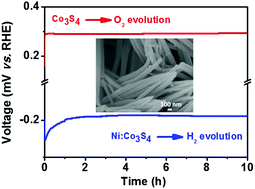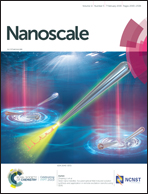Combining Co3S4 and Ni:Co3S4 nanowires as efficient catalysts for overall water splitting: an experimental and theoretical study†
Abstract
In the quest for mass production of hydrogen from water electrolysis, to develop highly efficient, stable and low-cost catalysts is still the central challenge. When designing a novel catalyst, it is necessary to optimize the exposure and accessibility of its active sites as well as the reaction kinetics. This can be realized by combining an appropriate chemical composition of the material, including doping with metal elements, and a properly nanostructured morphology offering a high surface contact. We report here on the design and performances of cobalt-based oxide and sulfide nanowires as catalysts that can be used for both hydrogen and oxygen evolution reactions (denoted HER and OER respectively) in the same compatible electrolyte. Following a sulfuration process, Co3O4 nanowires are entirely converted into Co3S4 nanowires showing greatly improved OER catalytic performances with an overpotential of 283 mV (instead of 371 mV for Co3O4) to deliver a current density of 10 mA cm−2. Besides, when doping the surface of these Co3S4 nanowires with small amounts of nickel, the resulting Ni:Co3S4 nanowires exhibit an HER overpotential of 199 mV to reach 10 mA cm−2. But most importantly, two-electrode electrolyzer cells combining Co3S4 and Ni:Co3S4 electrodes show operating voltages as low as 1.70 V at 10 mA cm−2 over 40 hours, a value that competes advantageously with the best reported catalysts in 1.0 M KOH. Meanwhile, density functional theory (DFT) calculations show that the free energy of the intermediates has been reduced after the introduction of sulfur and nickel atoms, which have smaller overpotentials and corresponding enhanced electrocatalytic performance. Our results open a new avenue in the quest for overall water splitting using electrochemical systems.



 Please wait while we load your content...
Please wait while we load your content...